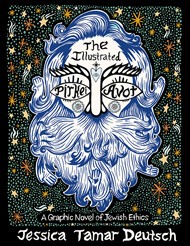When I am in prowling mode, I wander through the streets in search of excitement. Being easily satisfied by even a small quantity of excitement, my prowling generally gets no further than the Pomeranz family bookshop ("The Gan Eden of Jewish Books"), where I feast my eyes and occasionally empty my pockets on the serried ranks of Jewish interest publications. If Gan Eden could ever (Heaven forfend!) be described as the Garden of Earthly Delights, Pomeranz's mini-paradise could be termed the Garden of Unearthly Delights, given the high spiritual and/or inspirational content of so many of the books on sale there.
My most recent visit found me drawn, as usual, to the shelf with books on Jewish ethics. There I found two with which I made not previously been acquainted.
The first, published in Jerusalem way back in 1983 by Gefen, is A Companion to Pirke Avot by the late Rabbi Benjamin Morgenstern. This book, the dust jacket states at the outset and in the author's Introduction, is not a commentary to Avot but a companion. In truth it is more of a work of history-cum-biography since its content is arranged around the personalities of no fewer than 22 rabbis. Only 19 of those discussed are actually contributors to Avot: Rabban Gamliel of Yavneh and Rabbi Natan HaBavli also feature and there is a short but welcome chapter on the mysterious and elusive Menachem -- Hillel's "partner" before Shammai's arrival on the scene. Rabbi Morgenstern's position is that the sayings of the Tannaim of Avot, many of which are "terse or even laconic", might be understood and more properly appreciated if they were learned within the context of events in which their author may have participated or been an observer.At 221 pages and with recommended references for further study, this book is a comfortable and informative read. In an ideal world it would have been a little longer, with room for discussion of Rabbi Elazar ben Arach (another candidate for the true identity of Rabbi Nehorai, whom the author exclusively identifies as Rabbi Meir) and a little speculation concerning the status of Rabbi Yehoshua ben Levi (was he, or was he not, a Tanna?) Frustratingly, we have to accept that there is so little biographical information about some of the rabbis of Avot that it would not have been feasible to find more than a brief paragraph to say about them.
************************************
The second book I encountered, fresh off the printing press, is Dr Ari Ciment's Pirkei Dr Ari, published by Mosaica Press of Bet Shemesh. A much larger and indeed heavier work than that of Rabbi Morgenstern (at 576 pages) it is an agreeably easy read, with clear, well-spaced typography that facilitates the reader's effortless turning of pages.
This work too is not a conventional commentary on Pirkei Avot. Subtitled "Connecting Pirkei Avos to the Parashah", it leads the reader through not just each week's Torah reading but also to that of the main festivals. Each parashah opens with quotes from one or more mishnayot of Avot which are immediately followed by questions that are designed to focus the reader's thoughts on both the mishnah and the Torah reading. Most parshiyot are treated to more than one Avot-led discussion.
This methodology is somewhat reminiscent of that of Rabbenu Bachye ben Asher's prefixing each week's Torah analysis with a relevant verse from Mishlei (Proverbs), but works rather more easily for two reasons: (i) the mishnayot of Avot are generally more accessible and better known to contemporary readers than are the verses of Mishlei; (ii) the author helpfully concludes each essay with takeaway messages or answers to ensure that the reader never misses the point.
Dr Ciment, the author, is an expert on Jewish medical ethics, a topic that he has taught at Touro College. More importantly than that, he is a genuine enthusiast for life and for everything that a study of Torah combined with Avot can offer. This is not so much a Torah narrative or a commentary on Avot as a labour of love. His publishers, Mosaica, summarise this book thus:
The Torah is not meant as a history book but as a practical guide for us to live by. Pirkei Avos is the Mishnaic tractate that is a compilation of the ethical teachings passed down from Moshe Rabbeinu. This book highlights the connection between each parashah and Pirkei Avos, thereby uncovering practical takeaway messages. This is Pirkei Avos in the parashah — Pirkei Dr. Ari!
















